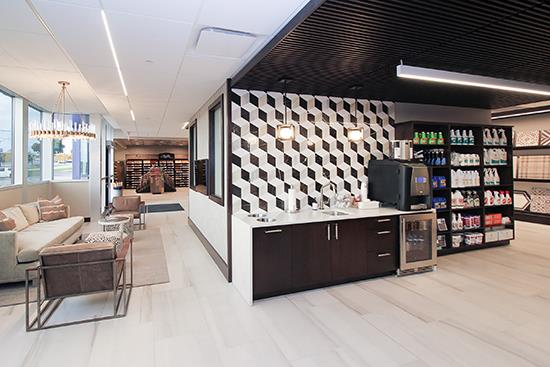Retail Top 100: Buoyed by strong demand and despite myriad challenges, the top 100 residential dealers continue to post healthy gains - Nov 2021
By Darius Helm
The residential flooring market of 2020, defined by the shutdowns in the spring and the surge of business in the second half of the year, yielded a complex set of challenges this year, and those residential dealers best able to pivot, adapt and navigate through these volatile market conditions have managed substantial gains.
One would be hard pressed to look back and find a time when this industry was beset by so much adversity: clogged ports, rising material costs, travel restrictions, supply limitations, labor shortages, domestic transportation issues. All of these issues relate to each other and in many ways compound each other, but a lot of it tracks back to the early summer of 2020 and demand for flooring products coming back faster than producers had anticipated. Coupled with manufacturing disruptions due to the pandemic itself, the ensuing waves of product headed to market sent ripples across all sorts of markets, services and industries, including homebuilding.
STATE OF THE MARKET
The sheer volume of this wave of demand has driven gains in the residential flooring market, even though the pace of these gains has been attenuated by the various bottlenecks, including the slowdown in homebuilding cycles and sales-the silver lining being that this volume of demand will stretch ahead and should keep the market strong in 2022.
In fact, many of the retailers and industry experts contacted by Floor Focus for this report feel that this slowing pace is not necessarily a negative, not just because of the prospects of sustained growth but also because, even if residential dealers and homebuilders had everything they needed when they needed it, they wouldn’t have the labor force to put it in.
Attracting prospects to the flooring industry, particularly flooring installation, was a problem well before the pandemic. When it comes to the trades, flooring installers rank at the lower end in pay scale. In order to keep up with demand, many flooring retailers have increased their installers’ wages. And while this has kept many installation crews intact, the experienced, knowledgeable installers leaving the business are not being replaced at a sufficient rate.
Also impacting residential dealers is the cost of doing business during this period of volatility and uncertainty. Price increases-several over the last year-have hurt margins, even as the bulk of those price increases are passed down the line. Another cost that many retailers have had to take on is additional warehousing. Many of the bigger operations have invested in new warehouses in order to build and maintain the stock necessary to fulfill orders in a comparatively timely manner. And there’s also the manpower cost of maintaining the flow of supply-meeting with core vendors, seeking out and vetting other vendors to meet demand, adjusting timelines and doing more troubleshooting than ever. In addition, Covid precautions have impacted efficiencies in countless ways.
Retailers report that residential remodel business has been strong all year, with some reporting a lull in the summer, perhaps reflecting a return to vacation spending. Business is up in all regions, but some of the hottest markets seem to be in the Midwest and West. And most dealers feel that next year will also bring growth, though at a more moderate pace.
In the first half of the year, the single-family builder segment grew in the region of 15%, according to most estimates, and since then the rate of business has slowed in some markets, depending on sourcing issues and longer cycle times. In Colorado, for instance, the surging builder market has pushed up prices, and at the same time, builders are slowing their home sales in order to move more in sync with the slower build cycles.
On the multifamily side, apartment turns, which have been stagnant since the start of the pandemic, have been picking up. The end of the national eviction moratorium on August 26 may add some activity to this category, and only a handful of states-Minnesota, Washington, New York, New Mexico and New Jersey-and the District of Columbia have extended eviction protections.
Rental rates are rising at record speeds. According to Yardi Matrix, a commercial real estate data firm, asking rents year over year from August 2020 to August 2021 rose by double digits (10.5%) for the first time ever. Single-family rentals continue to grow at a faster rate than multifamily, reflecting the demand for suburban living, though at the same time urban markets are also gaining.
Multifamily new construction is also picking up. According to the National Association of Realtors, multifamily permits have been gaining faster than single-family through the summer months, and dealers in the multifamily market also report an increase in projects.
New home sales have been moving up and down throughout the year. Through May, year-over-year numbers showed gains, but in the last few months, year-over-year numbers have fallen below the breakneck pace of 2020-with August 2021 24.3% below August 2020. In terms of existing-home sales, year-over-year numbers peaked in May, 44.65% above May 2020, but the rate has slowed in recent months, falling behind year-over-year rates in August.
The Pending Home Sales Index increased 8.1% in August, though year-over-year new signings were down 8.3%. And housing starts in September slid 1.6% from August, in terms of the seasonally adjusted annual rate, and rose 7.4% year over year.
For the complete story of the Top 100 Retailers, see the November 2021 issue of Floor Focus Magazine.
Copyright 2021 Floor Focus
